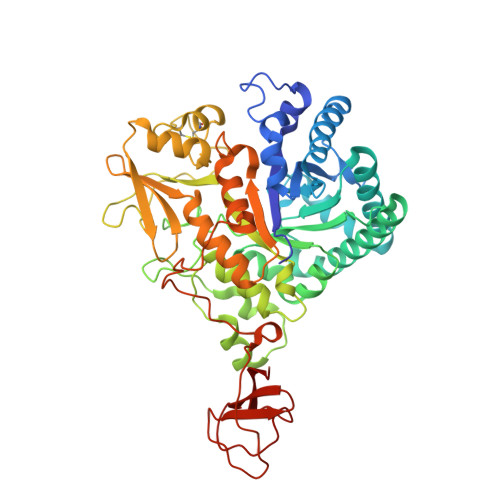Observation of the controlled assembly of preclick components in the in situ click chemistry generation of a chitinase inhibitor
Hirose, T., Maita, N., Gouda, H., Koseki, J., Yamamoto, T., Sugawara, A., Nakano, H., Hirono, S., Shiomi, K., Watanabe, T., Taniguchi, H., Sharpless, K.B., Omura, S., Sunazuka, T.(2013) Proc Natl Acad Sci U S A 110: 15892-15897
- PubMed: 24043811
- DOI: https://doi.org/10.1073/pnas.1315049110
- Primary Citation of Related Structures:
3WD0, 3WD1, 3WD2, 3WD3, 3WD4 - PubMed Abstract:
The Huisgen cycloaddition of azides and alkynes, accelerated by target biomolecules, termed "in situ click chemistry," has been successfully exploited to discover highly potent enzyme inhibitors. We have previously reported a specific Serratia marcescens chitinase B (SmChiB)-templated syn-triazole inhibitor generated in situ from an azide-bearing inhibitor and an alkyne fragment. Several in situ click chemistry studies have been reported. Although some mechanistic evidence has been obtained, such as X-ray analysis of [protein]-["click ligand"] complexes, indicating that proteins act as both mold and template between unique pairs of azide and alkyne fragments, to date, observations have been based solely on "postclick" structural information. Here, we describe crystal structures of SmChiB complexed with an azide ligand and an O-allyl oxime fragment as a mimic of a click partner, revealing a mechanism for accelerating syn-triazole formation, which allows generation of its own distinct inhibitor. We have also performed density functional theory calculations based on the X-ray structure to explore the acceleration of the Huisgen cycloaddition by SmChiB. The density functional theory calculations reasonably support that SmChiB plays a role by the cage effect during the pretranslation and posttranslation states of selective syn-triazole click formation.
- The Kitasato Institute, Kitasato Institute for Life Sciences and Graduate School of Infection Control Sciences, and School of Pharmacy, Kitasato University, Tokyo 108-8641, Japan.
Organizational Affiliation:



















